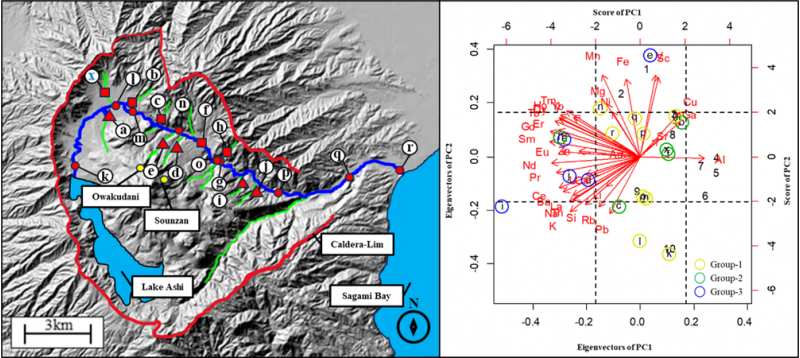
Principal component analysis for the elemental composition of sedimentary sands in the Hayakawa River of Hakone Caldera, Japan
ABSTRACT

Riverbed sediments from 19 Hayakawa River sites in Hakone Caldera Japan were analyzed for 37 elements, categorized into three groups by location: Group-1 (nine mainstream samples), Group-2 (five tributary samples with somma upstream), and Group-3 (five tributary samples with central volcanic cones upstream). Principal component analysis (PCA) showed the 3PCs explain approximately 77% of the total variance. The first principal component (PC1) is derived from the inverse correlation between Al and a group including Na, K, and rare earths elements (REE), likely due to their weathering, and their acidic alteration. Groups 1 and 2 sediments might be more influenced by this weathering or acidic alteration than Group-3. The PC2 was characterized by elements enriched in volcanic ash, such as Sc, V, Mn, Fe, and Cu, showing no significant score differences among the three groups. The PC3 was characterized by the correlation among Li, Al, Cu, Ga, Rb, and Sr, with no significant score variations among the three groups. Arsenic showed loadings below 0.5 in PC1 to PC3, indicating its limited contribution to the overall sample characteristics. However, a specific site with upstream volcanic hot spring discharge exhibited high As content, implying possible sediment contamination by As-bearing minerals like pyrite. This suggests the possibility of using As content in riverbed sediments to detect volcanic activity. This study’s results indicate that the elemental composition of riverbed sediments could be associated with the weathering and acidic alteration of volcanic rocks from Hakone Volcano, indicating the potential to identify areas influenced by geothermal activity.
KEYWORDS
Keywords: riverbed sediment, elemental analysis, Hakone Volcano, principal component analysis, arsenic- Published : 2024
- Released on J-STAGE : 2024/08/28
- Received : 2024/01/17
- Accepted : 2024/06/24
- DOI : https://doi.org/10.2343/geochemj.GJ24013
- J-STAGE URL : https://www.jstage.jst.go.jp/article/geochemj/58/4/58_GJ24013/_article/-char/en
- J-Online ISSN: 1880-5973
- Print ISSN : 0016-7002
- ISSN-L : 0016-7002
All Issues
- Vol.59, 2025
- Vol.58, 2024
- Vol.57, 2023
- Vol.56, 2022
- Vol.55, 2021
- Vol.54, 2020
- Vol.53, 2019
- Vol.52, 2018
- Vol.51, 2017
- Vol.50, 2016
- Vol.49, 2015
- Vol.48, 2014
- Vol.47, 2013
- Vol.46, 2012
- Vol.45, 2011
- Vol.44, 2010
- Vol.43, 2009
- Vol.42, 2008
- Vol.41, 2007
- Vol.40, 2006
- Vol.39, 2005
- Vol.38, 2004
- Vol.37, 2003
- Vol.36, 2002
- Vol.35, 2001
- Vol.34, 2000
- Vol.33, 1999
- Vol.32, 1998
- Vol.31, 1997
- Vol.30, 1996
- Vol.29, 1995
- Vol.28, 1994
- Vol.27, 1993
- Vol.26, 1992
- Vol.25, 1991
- Vol.24, 1990
- Vol.23, 1989
- Vol.22, 1988
- Vol.21, 1987
- Vol.20, 1986
- Vol.19, 1985-1986
- Vol.18, 1984
- Vol.17, 1983
- Vol.16, 1982
- Vol.15, 1981
- Vol.14, 1980
- Vol.13, 1979
- Vol.12, 1978
- Vol.11, 1977
- Vol.10, 1976
- Vol.9, 1975
- Vol.8, 1974
- Vol.7, 1973
- Vol.6, 1972-1973
- Vol.5, 1971
- Vol.4, 1970-1971
- Vol.3, 1969-1970
- Vol.2, 1968
- Vol.1, 1966-1967




